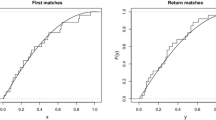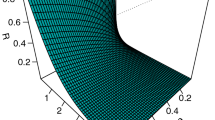Abstract
The paper is inspired by the stress–strength models in the reliability literature, in which given the strength (Y) and the stress (X) of a component, its reliability is measured by P(X < Y). In this literature, X and Y are typically modeled as independent. Since in many applications such an assumption might not be realistic, we propose a copula approach in order to take into account the dependence between X and Y. We then apply a copula-based approach to the measurement of household financial fragility. Specifically, we define as financially fragile those households whose yearly consumption (X) is higher than income (Y), so that P(X > Y) is the measure of interest and X and Y are clearly not independent. Modeling income and consumption as non-identically Dagum distributed variables and their dependence by a Frank copula, we show that the proposed method improves the estimation of household financial fragility. Using data from the 2008 wave of the Bank of Italy’s Survey on Household Income and Wealth we point out that neglecting the existing dependence in fact overestimates the actual household fragility.
Similar content being viewed by others
References
Adimari G, Chiogna M (2006) Partially parametric interval estimation of Pr(Y > X). Comput Stat Data Anal 51: 1875–1891
Azzalini A, Dal Cappello T, Kotz S (2003) Log-skew-normal and log-skew-t distributions as models for family income data. J Income Distrib 11: 13–21
Balakrishnan N, Lai CD (2009) Continuous bivariate distributions. 2nd. Springer, New York
Bandourian R, McDonald JB, Turley RS (2003) A comparison of parametric models of income distribution across countries and over time. Estadistica 55: 135–152
Brandolini A, Cannari L (1994) Methodological appendix: the bank of Italy’s survey of household income and wealth. In: Ando A, Guiso L, Visco I (eds) Saving and the accumulation of wealth: essays on Italian household and government saving behavior. Cambridge University Press, Cambridge, pp 369–386
Brown S, Taylor K (2008) Household debt and financial assets: evidence from Germany, Great Britain and the USA. J R Stat Soc Ser A 171(3): 615–643
Christelis D, Jappelli T, Paccagnella O, Weber G (2009) Income, wealth and financial fragility in Europe. J Eur Soc Policy 19: 359–377
Dagum C (1977) A new model of personal income distribution: specification and estimation. Econ Appl XXX: 413–437
Domma F, Giordano S (2009) Dependence in stress-strength models with FGM copula and Burr III margins. In: Ingrassia S, Rocci R (eds) Book of short papers of the meeting of the classification and data analysis. CLEUP, Padova, pp 477–480
Genest C, Remillard B, Beaudoin D (2009) Goodness-of-fit tests for copulas: a review and a power study. Insur: Math Econ 44: 199–213
Gupta RD, Gupta RC (1990) Estimation of P(a′x > b′y) in the multivariate normal case. Statistics 1: 91–97
Gupta RC, Ghitany ME, Al-Mutairi DK (2012) Estimation of reliability from a bivariate log-normal data. J Stat Comput Simul. doi:10.1080/00949655.2011.649284
Huang K, Mi J, Wang Z (2012) Inference about reliability parameter with gamma strength and stress. J Stat Plan Inference 142(4): 848–854
Jappelli T, Pagano M, Di Maggio M (2008) Households’ indebtedness and financial fragility. CSEF Working Papers, N. 208
Jappelli T, Pistaferri L (2010) The consumption response to income changes. Annu Rev Econ 2: 479–506
Joe H (1997) Multivariate models and dependence concepts, monographs in statistics and probability 73. Chapmann and Hall, New York
Joe H (2005) Asymptotic efficiency of the two-stage estimation method for copula-based models. J Multivar Anal 94: 401–419
Kleiber C (2008) A guide to the Dagum distribution. In: Duangkamon C (ed) Modeling income distributions LorenzCurvesSeries: EconomicStudies in inequality, social exclusion and well-being, 5. Springer, New York
Kotz S, Lumelskii Y, Pensky M (2003) The stress-strength models and its generalizations. World Scientific Publishing, Singapore
Krishnamoorthy K, Lin Y (2010) Confidence limits for stress-strength reliability involving Weibull models. J Stat Plann Inference 140: 1754–1764
Lusardi A, Schneider D, Tufano P (2011) Financially fragile households: evidence and implications. CeRP Working Papers, N. 116
Nadarajah S (2005) Reliability for some bivariate beta distributions. Math Prob Eng 2005(2): 101–111. doi:10.1155/MPE.2005.101
Nadarajah S, Kotz S (2005) Reliability for some exponential distributions. Math Probl Eng 2006: 1–14
Nelsen RB (2006) An introduction to copulas. Springer, New York
R Development Core Team (2011) R: A language and environment for statistical computing. R Foundation for Statistical Computing, Vienna, Austria. ISBN 3-900051-07-0. http://www.R-project.org
Rezaei S, Tahmasbi R, Mahmoodi M (2010) Estimation of P(Y < X) for generalized Pareto distribution. J Stat Plan Inference 140: 480–494
Sengupta S (2011) Unbiased estimation of P(X > Y) for two-parameter exponential populations using order statistics. Statistics 45(2): 179–188
Author information
Authors and Affiliations
Corresponding author
Rights and permissions
About this article
Cite this article
Domma, F., Giordano, S. A stress–strength model with dependent variables to measure household financial fragility. Stat Methods Appl 21, 375–389 (2012). https://doi.org/10.1007/s10260-012-0192-5
Accepted:
Published:
Issue Date:
DOI: https://doi.org/10.1007/s10260-012-0192-5




